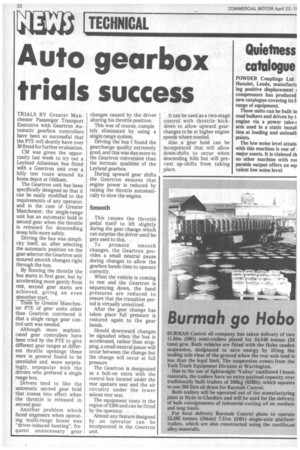Auto gearbox trials success
Page 24

If you've noticed an error in this article please click here to report it so we can fix it.
TRIALS BY Greater Manchester Passenger Transport Executive with Geartron Automatic gearbox controllers have been so successful that the PTE will shortly have over 30 fitted for further evaluation.
CM was given the opportunity last week to try out a Leyland Atlantean bus fitted with a Geartron unit over a hilly test route around its home depot at Oldham.
The Geartron unit has been specifically designed so that it can be easily modified to the requirements of any operator, and in the case of Greater Manchester, the single-range unit has an automatic hold in second gear when the throttle is released for descending steep hills more safely.
Driving the bus was simplicity itself, as, after selecting the automatic position on the gear selector the Geartron unit ensured smooth changes right through the box.
By flooring the throttle the bus starts in first gear, but by accelerating more gently from rest, second gear starts are achieved, giving an even smoother start.
Trails by Greater Manchester PTE of gear units other than Geartron convinced it that a single range gear control unit was needed.
Although more sophisticated gear controllers have been tried by the PTE to give different gear ranges at differ ent throttle openings these were in general found to be unreliable and, more surprisingly, unpopular with the drivers who prefered a single range box.
Drivers tend to like the automatic second gear hold that comes into effect when the throttle is released in second gear.
Another problem which faced engineers when operat ing multi-range boxes was "driver-induced hunting", frequent unnecessary gear changes caused by the driver altering his throttle position.
This was of course, comple tely eliminated by using a single range system.
Driving the bus I found the gearchange quality extremely good, and this was due more to the Geartron conversion than the intrinsic qualities of the Leyland gearbox.
During upward gear shifts the Geartron ensures that engine power is reduced by raising the throttle automatically to slow the engine.
Smooth
This causes the throttle pedal itself to lift slightly during the gear change which can surprise the driver until he gets used to this.
To promote smooth changes, the Geartron provides a small neutral pause during changes to allow the gearbox bands time to operate correctly.
When the vehicle is coming to rest and the Geartron is sequencing down, the band pressures are reduced to ensure that the transition period is virtually unnoticed.
After the gear change has taken place full pressure is restored again to the gear bands.
Should downward changes be signalled when the bus is accelerated, rather than stopping, a small neutral pause will occur between the change but the change will occur at full pressure.
The Geartron is designated as a bolt-on extra with the control box located under the rear upstairs seat and the air circuitry under the lower saloon rear seat.
The equipment costs in the region of E200 and can be fitted by the operator.
Almost any feature designed by an operator can be incorporated in the Geartron unit. It can be used as a two-stage control with throttle kickdown to allow upward gearchanges to be at higher engine speeds where needed. Also a gear hold can be incorporated that will allow down-shifts to occur when descending hills but will prevent up-shifts from taking place.




















































































